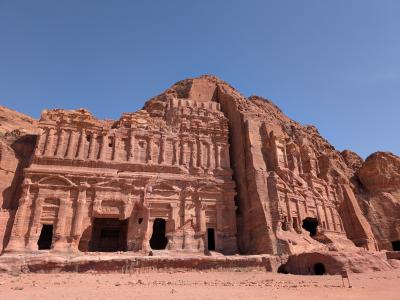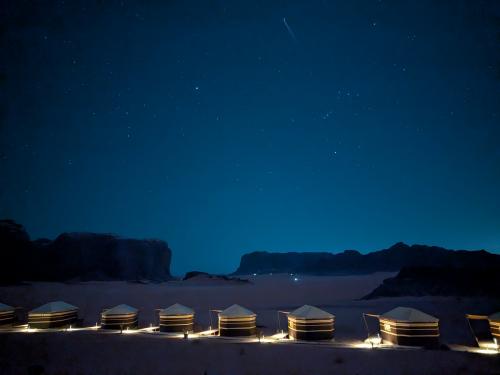Deserted adventure in Jordan

AMMAN- Trips to the safe and stable country Jordan are currently heavily discounted due to continued fighting in Gaza.
So, we spent the first two nights in the capital city. Fresh off our 40 Euro flight from Rome, I realized that when the plane slammed onto the runway, Ryan Air passed the “smooth landing savings” on to you. It was decided that renting a car was the best way to spend a week to see the sights. Thirty minutes later, we were in a somewhat new five-star hotel at an extremely reasonable price just outside the center.
“Visitors are way down due to the situation in Gaza,” said our walking tour guide, Mohammed, how grew up in Amman, which may have explained the reasonable accommodation prices. He met us on a hotel rooftop café in the center for a coffee before the tour. The roof had a great view of the Roman Theater and many other sites in the center. We mostly focused on the history of the city and then walked through the markets as he explained the daily activities of locals. Most of the parts that we saw were relatively new compared to the ancient sites, and the city has greatly expanded during the 20th century.
Three hours away by car, Petra was easy to get to and offered plenty of detours along the way. We stopped at Mount Nebo for 30 minutes to walk through an area said to be the place where Moses first saw the Promised Land. Marked by a church filled with ancient mosaics, a small museum, and a great overlook, the pleasant stop offered us a way to stretch our legs. We had purchased a three-day ticket option for Petra which was included with the Jordan Pass. It’s a much cheaper option than buying the visa for Jordan and the Petra tickets separately. The pass also included many other museums and activities throughout the country.
We dropped our bags at the hotel and off we were to see the Treasury, the main sight in Petra. Our hotel was right next to the park, but the walk to the Treasury was still significant, about three kilometers. After waving off plenty of horse-ride vendors who aggressively state the ride is included in your ticket (although the expected high tip is not), we saw the most popular site.
As we arrived at the end of the Siq, a narrow rock valley caused by an earthquake centuries ago, we had our first view of the Treasury, the most iconic of the tombs in Petra. The experience and the architecture were quite striking even with high expectations. We grabbed some photos, climbed to a small overlook, and then moved on to the rest of the site before closing time. We grabbed a mint lemonade at a concession tent run by a Bedouin family near the Roman Theater that was carved out of the sandstone.
Two things struck me about Petra: first, how much more there was to see beyond the Treasury, and second, how empty it was. “Now we have around 500 visitors per day when we usually have over 2,000 during this period,” said our guide, Salah, during a four-hour walking tour we took the following day. They had received several cancelations after the war in Gaza resumed. The tour was informative and included several suggested hikes with the best vantage points over all the sites. The following morning was our last in Petra, and I rushed down to the site to catch it at the opening. The sunrise hike was worth it given that the site was almost completely empty,
Our next stop was Wadi Rum, a protected UNESCO heritage site famous for its Mars-like atmosphere. We spent two nights in a Bedouin camp. The camp’s 16 luxury tents, well-appointed with showers and bathrooms, were half full the first night and even less than that the second night. Our tent included a full clear window which opened to the star-filled sky at night and provided a unique experience.
Dinner was served communally in the large tent. The local Bedouin family that ran the camp gave us a demonstration of how they cook meals underground. Using a zarb, a traditional Bedouin underground oven which is created by digging a hole, cooking down wood until it turns into coals, placing the coals and the food on a multilevel tray into the hole, and then burying them with sand for several hours. The time and effort came across in the flavor of the marinated lamb, chicken, and vegetables.
“This used to be our living room,” explained Mohamed, referring to the place where he and his brother were raised and had spent their lives growing up in the desert. The secluded camp had an amazing view of large red mountains across a vast plain of red sand.
After breakfast, we headed out for an all-day tour to see the major sites of Wadi Rum which included Lawrance of Arabia’s former house, many short hikes, a few rock bridges, a Bedouin desert lunch cooked by our guide in the back of his pickup truck, and our favorite part, coming up close with wild camels. Again, the most popular sites seemed half full.
Driving around, we noticed several traditional Bedouin camps (just basic tents) that seemed empty. Our guide mentioned that they are older camps, and that most visitors prefer the luxury “igloo” tents which became popular after the recent movie, The Martian, came out (filmed in Wadi Rum).
The next morning, we drove to Aqaba, just to see the little piece of Jordan that shares the Red Sea with Isreal, Egypt, and Saudi Arabia. We had a refreshing traditional seafood lunch before making our final drive to Amman and leaving the next day.
The whirlwind week in Jordan was quite an adventure. Petra surpassed expectations and, in some places, it seemed like we had the place to ourselves - a surreal experience. However, when speaking with the locals in the tourism industry, they were saddened by the lack of tourists (in other words, income), and many small companies have closed shop even after surviving Covid. There are some signs of hope on the Horizon. Our guide in Amman said things had picked up at the end of April.
mlp


© COPYRIGHT ITALIAN INSIDER
UNAUTHORISED REPRODUCTION FORBIDDEN


